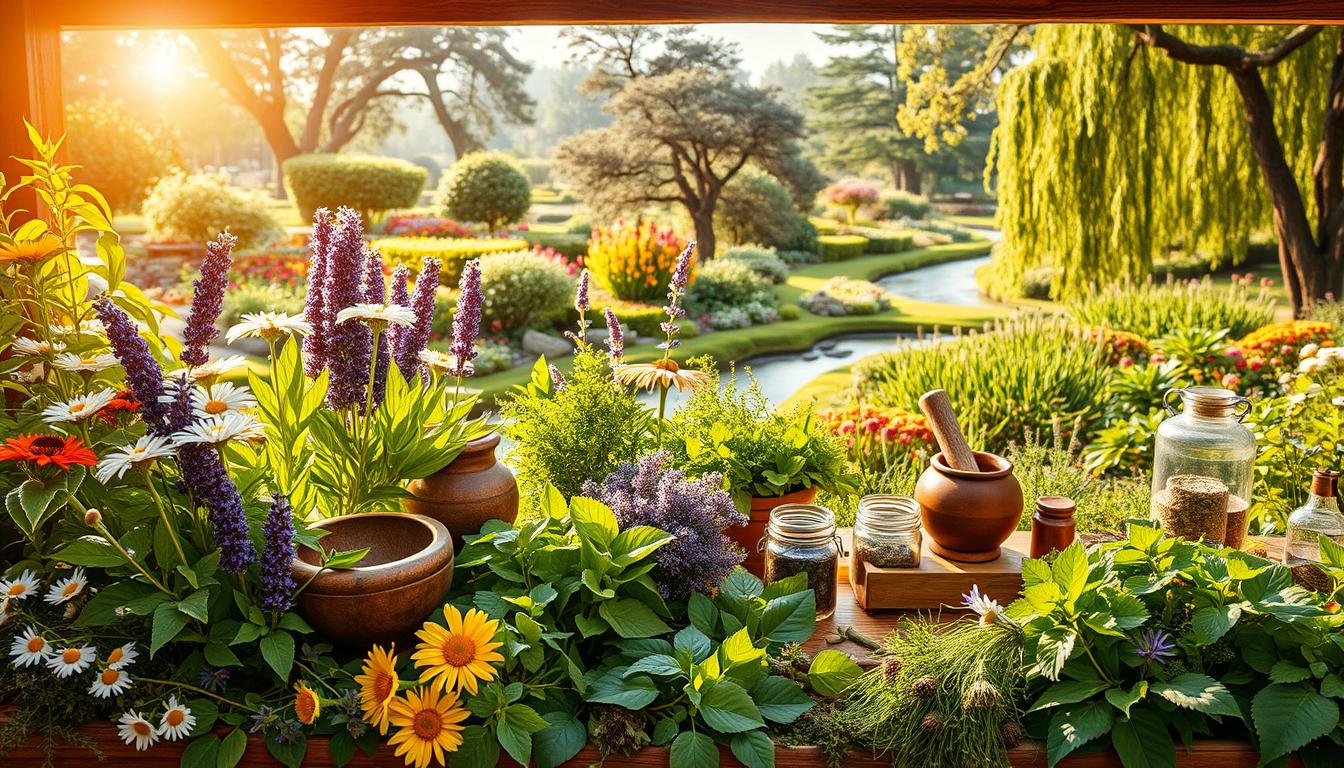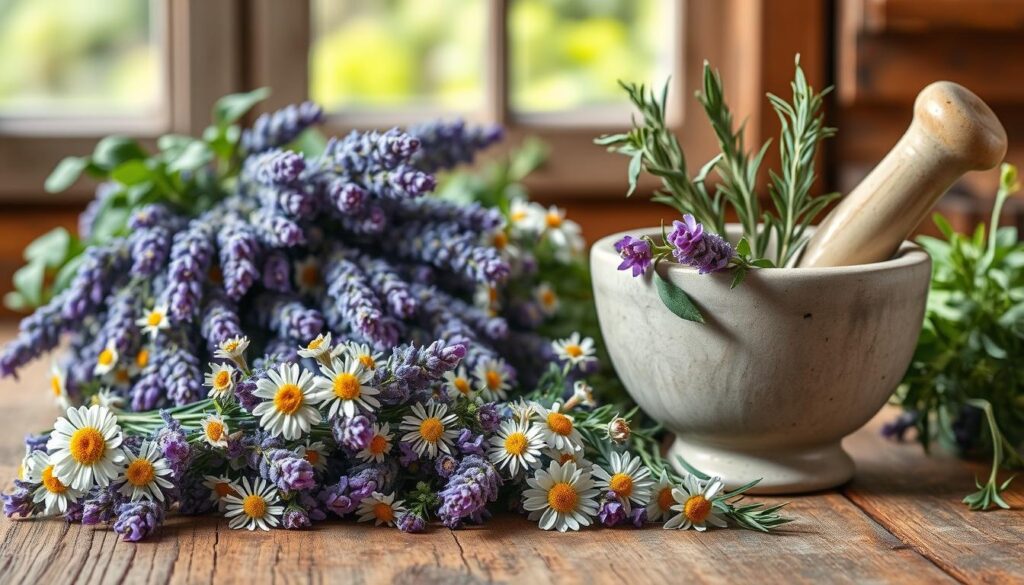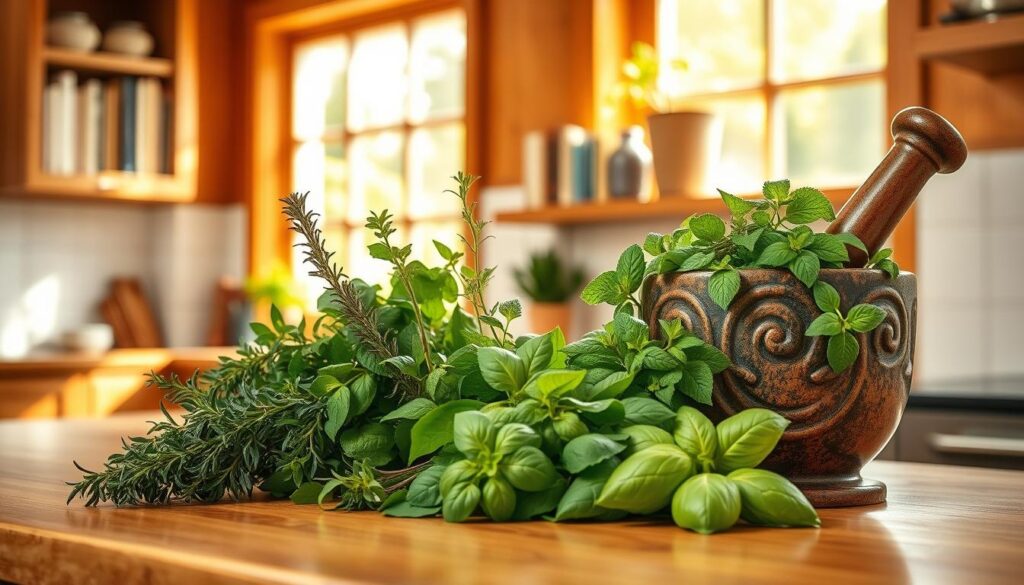Physical Address
304 North Cardinal St.
Dorchester Center, MA 02124
Physical Address
304 North Cardinal St.
Dorchester Center, MA 02124

For centuries, cultures worldwide have relied on plant-based solutions to treat ailments. From soothing inflammation to boosting heart function, nature offers powerful alternatives. But how effective are they compared to modern prescriptions?
Traditional systems like Ayurveda and Chinese practices prioritize balance—mind, body, and environment. Lesser-known options, like gymnema sylvestre, even support blood sugar control. The best part? Many double as kitchen staples or tea ingredients.
This guide explores how these natural wonders work. You’ll discover their science-backed perks and simple ways to use them daily. Ready to rethink wellness?
Long before pharmacies existed, people turned to nature for healing. Today, plant-based remedies remain a cornerstone of wellness, blending ancient wisdom with modern science. Whether brewed as tea or taken as supplements, their enduring legacy fascinates researchers and practitioners alike.
It’s the use of leaves, roots, or flowers to treat physical or mental conditions. Unlike synthetic drugs, these remedies work holistically, often with fewer side effects. For example, chamomile calms nerves while ginger eases digestion.
Archaeologists found 60,000-year-old Neanderthal burial sites with medicinal herbs. The Egyptian Ebers Papyrus (1550 BCE) lists 850 plant-based cures, from aloe for burns to garlic for heart health. These traditions laid the groundwork for systems like Ayurveda and Traditional Chinese Medicine.
Nearly 80% of the global population still relies on botanicals, per the WHO. In the U.S., 38% of adults use them alongside prescriptions, especially for chronic issues like arthritis. Clinics now integrate turmeric for inflammation and peppermint for IBS, proving their relevance in contemporary care.
From Neanderthals to NIH studies, herbal medicine bridges past and present. Its adaptability—whether in teas, tinctures, or tablets—makes it a timeless way to use nature’s pharmacy.
Modern science is now unlocking how plant compounds interact with our biology. These natural solutions don’t just mask symptoms—they target root causes with fewer side effects. Let’s explore the chemistry and research validating their role in wellness.
Plants contain bioactive molecules that bind to receptors in our body. For example, piperine in black pepper boosts curcumin absorption by 2000%. This synergy solves bioavailability challenges, making combos like turmeric + pepper powerful.
Five major compounds deliver benefits:
Cinnamon’s cinnamaldehyde, a terpenoid, lowers blood sugar by 29%. These compounds often work best in whole-plant form, not isolated.
A 2023 meta-analysis of 217 trials found botanicals effective for 78 conditions. The FDA now outlines guidelines for standardized extracts, ensuring consistency. NIH-funded research shows ashwagandha reduces cortisol by 34.2% in stressed adults.
From immune system support to cognitive function, spices and herbs offer clinically backed solutions. Their multi-target approach makes them unique allies in holistic health.
Every spice rack doubles as a mini medicine cabinet when you know which plants pack a punch. These kitchen staples do more than enhance flavor—they deliver science-backed benefits, from stabilizing blood sugar to supporting heart health. Here’s how four powerhouses stand out.
Just 1.5 teaspoons daily can lower blood sugar levels, studies show. Opt for Ceylon cinnamon (“true” cinnamon) over cassia—it has less coumarin, a compound that may harm the liver in high doses. Stir it into oatmeal or smoothies for a steady energy boost.
Curcumin, its active compound, blocks COX-2 enzymes like ibuprofen—but without the stomach risks. Pair it with black pepper to enhance absorption. Try golden milk or roasted veggies dusted with turmeric for a soothing effect.
A JAMA-published trial found 1g of ginger reduced chemotherapy-induced nausea by 40%. Fresh ginger tea or grated root in stir-fries can ease stomach discomfort naturally.
Crushed garlic releases allicin, slashing LDL cholesterol by 10–15%. Aged garlic extract may drop blood pressure by 7.5 mmHg. Add raw garlic to dressings or roast it to mellow the flavor while keeping perks.
These herbs spices prove wellness can be as simple as seasoning smarter. Whether you’re managing a condition or just boosting your immune system, their versatility makes them easy to embrace daily.
Your gut health directly impacts overall wellness, and nature offers powerful solutions. Whether it’s occasional bloating or chronic discomfort, certain herbs work like targeted relief crews. Let’s explore three top performers backed by science.
Peppermint oil capsules improve IBS symptoms in 79% of patients. The key is form: enteric-coated capsules prevent early breakdown, delivering menthol directly to the intestines. For milder issues, tea made from fresh leaves relaxes stomach muscles.
| Form | Best Use Case | Dosage |
|---|---|---|
| Capsules | Moderate-to-severe IBS | 180–225mg daily |
| Tea | Mild cramping | 1–2 cups as needed |
Fennel seed tea reduces infant colic crying time by 65%. Its secret? Anethole, an antispasmodic compound that untangles trapped gas. Chew ½ teaspoon of seeds post-meals or steep them for a belly-warming brew.
Ginger’s prokinetic effect speeds up gastric emptying by 25%. Grate fresh root into stir-fries or sip ginger tea before meals. Avoid excessive licorice root—it may cause potassium loss (hypokalemia).
These herbs prove digestive relief doesn’t require harsh chemicals. With the right use, they’re gentle yet effective allies for your gut.
Your immune system gets a natural upgrade with these powerful botanicals. From shortening colds to fending off flu, plants like echinacea and elderberry are *often used* for their protective effects. Here’s how they work—and how to use them wisely.
A Cochrane Review found echinacea cuts cold duration by 1.4 days. Not all species work equally: Echinacea purpurea (aerial parts) is more effective than angustifolia (roots). Choose alcohol-based tinctures or standardized extract for best results.
| Type | Best For | Dosage |
|---|---|---|
| Purpurea | Prevention | 300mg 3x daily |
| Angustifolia | Acute symptoms | 1mL tincture every 3 hours |
Elderberry syrup slashes flu symptoms by 4 days. Its flavonoids block viruses from entering cells. Look for syrups with 15% anthocyanins or make tea from dried berries. Avoid raw berries—they’re toxic.
Astragalus polysaccharides activate NK cells, your body’s virus fighters. A 2021 study showed 500mg daily reduced upper respiratory infections by 38%. Caution: Those with autoimmune conditions should avoid it—it may overstimulate the immune system.
Whether as teas, supplements, or extracts, these herbs offer science-backed defense. Just remember: They’re allies, not replacements for medical care.
Feeling overwhelmed? Nature’s calming botanicals can help reset your stress response. These plants work with your body to lower cortisol, ease tension, and promote relaxation—no prescription needed.

Holy basil (tulsi) is a star adaptogen. It reduces stress markers by 39% in research trials. Unlike caffeine, it boosts energy without jitters. Try tulsi tea or capsules for daily balance.
Chamomile’s apigenin binds to GABA receptors, mimicking anti-anxiety effects. Its bisabolol also relaxes muscles. Steep 2–3 tea bags for extra strength—ideal before bedtime.
This root slashes cortisol by 27.9%. Its *withanolides* support thyroid function too. Opt for KSM-66 supplements (300–600mg daily). Avoid mixing with sedatives like benzodiazepines.
| Adaptogen | Best For | Dose |
|---|---|---|
| Holy Basil | Daily stress | 500mg extract or tea |
| Ashwagandha | Chronic anxiety | 300–600mg KSM-66 |
| Rhodiola | Fatigue + focus | 200–400mg AM dose |
Pro tip: Cycle adaptogens—8 weeks on, 2 weeks off—to maintain effects. Pair with deep breathing for amplified results.
Your cardiovascular system thrives when supported by nature’s pharmacy. Certain botanicals offer targeted benefits, from improving circulation to stabilizing blood pressure. Here’s how three standout options can boost your heart health.
Hawthorn’s oligomeric procyanidins (OPCs) strengthen blood vessels and improve ejection fraction by 5.6% in heart failure patients. This makes it a top choice for those managing CHF.
Raw crushed garlic releases allicin, which helps lower blood pressure. Cooking reduces its potency—try adding minced garlic to dressings just before serving.
Studies show aged garlic extract can reduce systolic readings by 7.5 mmHg. For consistent results, aim for 600–1,200mg daily.
This fragrant spice acts as a natural ACE inhibitor. In trials, cardamom reduced systolic blood pressure by 15mmHg in 12 weeks.
Add it to:
Whether you’re sipping hawthorn tea or seasoning meals with garlic, these herbs offer delicious ways to support your cardiovascular system. Always consult your doctor before combining them with prescriptions.
Glowing skin starts with nature’s remedies. Certain botanicals offer targeted solutions for irritation, wounds, and inflammation. Their bioactive compounds work in harmony with your skin’s natural processes.
Fresh aloe gel accelerates burn healing by 9 days compared to conventional treatments. The plant’s polysaccharides lock in moisture while reducing redness.
Calendula’s triterpene alcohols boost collagen synthesis by 20%. This makes it ideal for cuts, scrapes, or dermatitis.
“Clinical trials show calendula ointment reduces post-surgery scar formation better than standard care.”
For sensitive skin, dilute calendula oil with coconut oil (1:10 ratio). Its bright orange petals also make a vibrant tea for internal healing.
Turmeric paste (mixed with neem) improves psoriasis symptoms in 76% of users. The root’s curcumin blocks inflammatory cytokines.
| Form | Use Case | Precautions |
|---|---|---|
| Paste | Psoriasis/eczema | Rinse after 15 mins to avoid staining |
| Infused oil | Joint pain | Dilute to 1% for sensitive skin |
Note: Turmeric increases photosensitivity. Always apply sunscreen after use.
Sharpening focus and memory doesn’t always require synthetic solutions. Certain botanicals offer research-backed ways to enhance brain function naturally. From boosting circulation to protecting neurons, these plants work with your body’s system to support mental clarity.
Inhaling rosemary’s aroma can improve recall by 15%. Its rosmarinic acid preserves acetylcholine, a neurotransmitter vital for learning. Studies show even small doses—like rosemary-infused olive oil—deliver noticeable effects.
Ginkgo increases cerebral blood flow by 12%, per NIH research. Its terpene lactones prevent platelet aggregation, enhancing oxygen delivery. This makes it a top choice for age-related cognitive support.
Caution: Ginkgo thins blood—avoid before surgeries or with anticoagulants. Standardized extracts (120–240mg daily) work best.
A 6-month trial found sage improved ADAS-cog scores by 4.6 points in early Alzheimer’s patients. Its antioxidants combat oxidative stress in the brain.
| Form | Benefits |
|---|---|
| Tea | Daily maintenance (1–2 cups) |
| Capsules | Standardized for clinical results |
Whether you’re seasoning dishes with rosemary or taking ginkgo supplements, these spices and herbs offer tasty ways to stay mentally sharp. Always consult a doctor before combining them with prescriptions.
Your body has built-in detox systems, but some plants can give them an extra boost. Certain roots and leaves help flush toxins, bind heavy metals, and support health at a cellular level. Let’s explore three top performers backed by science.
Burdock’s high inulin content feeds gut bacteria linked to liver function. This creates a gut-liver axis that helps filter toxins more efficiently. Its antioxidants also neutralize free radicals in the bloodstream.
Cilantro’s chlorogenic acid binds to lead and mercury, helping remove them in 42 days. For best results, pair it with NAC (N-acetylcysteine) to boost glutathione—your body’s master antioxidant.
“Studies show cilantro-chelation protocols reduce mercury levels by 38% compared to placebos.”
Add fresh leaves to smoothies or pesto. Avoid excessive amounts if you have gallbladder issues.
Dandelion boosts bile production by 87%, helping your liver process fats and toxins. Its bitter compounds stimulate digestion too.
| Form | Benefits |
|---|---|
| Tea | Gentle daily detox |
| Roasted root | Coffee substitute with liver perks |
Note: Those with bile duct obstructions should avoid dandelion root.
These herbs work best as part of a balanced approach. Stay hydrated, eat fiber-rich foods, and consult your doctor before starting any detox protocol—especially for heavy metals.
Chronic discomfort doesn’t always require a prescription. Nature provides powerful alternatives that target pain at its source. These herbs offer relief with fewer side effects than conventional options.
Willow bark contains salicin, which converts to salicylic acid—the same compound found in aspirin. A 240mg dose matches the effects of OTC NSAIDs for mild-to-moderate pain.
This African herb contains harpagosides that block COX-2 enzymes. Studies show it reduces arthritis pain by 42% when taken for 8+ weeks.
| Type | Dosage | Timeline |
|---|---|---|
| Powder | 1,500mg daily | 4 weeks for full effect |
| Tincture | 1mL 3x/day | Pain relief in 10 days |
Capsaicin in pepper depletes substance P—a pain neurotransmitter—by 80%. This makes it ideal for:
“Clinical trials show cayenne reduces diabetic nerve pain by 50% compared to placebos when used consistently.”
These plant-based options work best when matched to your specific pain type. Always consult a doctor before combining them with prescription meds.
Transform your kitchen into a wellness hub with these simple herb integration techniques. Whether through meals, beverages, or supplements, each method offers unique benefits. Let’s explore practical ways to make botanicals work for your lifestyle.
Fresh leaves pack more volatile oils than dried—use 3x the amount when substituting. Pair them strategically:
For oils, steep crushed garlic or thyme in warm (not hot) EVOO for 2 hours. This preserves active compounds while infusing flavor.

Water temperature and steep time vary by plant part:
| Type | Method | Duration |
|---|---|---|
| Leaves (mint) | Hot infusion | 5-7 minutes |
| Roots (ginger) | Decoction | 15-20 minutes simmer |
| Flowers (hibiscus) | Cold brew | 8 hours refrigerated |
Nighttime blends? Try chamomile + lemon balm. Morning boost? Match green tea with ginseng slices.
Standardized extracts ensure consistent potency. Look for these ratios:
Reputable brands like Gaia Herbs and Mountain Rose Herbs test for heavy metals. For stress support, take ashwagandha capsules at night—it works synergistically with circadian rhythms.
“Cold-processed tinctures preserve heat-sensitive compounds better than alcohol extracts for plants like echinacea.”
Remember: Whole food integration often provides better absorption than isolated capsules. Rotate your use every few months to prevent tolerance.
A 2019 study revealed startling gaps in herbal product quality—here’s how to stay protected. While botanicals offer gentle alternatives, they aren’t risk-free. Smart usage means understanding side effects, drug interactions, and quality markers.
Even benign-seeming plants can cause reactions. For example, licorice root may lower potassium dangerously with prolonged use. The FDA warns that St. John’s wort affects 50% of prescription drugs, from birth control to antidepressants.
Top precautions:
Some combinations pose serious risks. Always consult your doctor before mixing herbs and pharmaceuticals.
| Herb | Interacts With | Risk |
|---|---|---|
| Ginkgo biloba | Warfarin | Increased bleeding |
| Kava | SSRIs | Liver toxicity |
| Echinacea | Immunosuppressants | Reduced drug efficacy |
“Skullcap adulteration with germander—a liver toxin—caused 27 hospitalizations in 2018. Always verify species with microscopic testing.”
Nearly half of supplements fail purity tests. Look for the USP Verified Mark, which ensures:
Pregnant women should avoid black cohosh (uterine stimulant) and pennyroyal (liver damage). Third-party testers like ConsumerLab.com provide unbiased quality reports.
The safest way forward? Treat botanicals like medications—respect their power and verify their purity.
Nature’s pharmacy offers timeless solutions for modern wellness challenges. From ashwagandha’s stress relief to hawthorn’s heart support, these plant-based allies work best with consistent, mindful use.
Start small—add turmeric to soups or sip ginger tea daily. Quality matters: consult AHG-certified herbalists to tailor choices to your health needs.
Emerging tools like AI now predict herb-drug interactions, making integration safer. Your system thrives when supported by science-backed herbs.
Ready to begin? Pick three foundational options and let nature’s wisdom guide you.